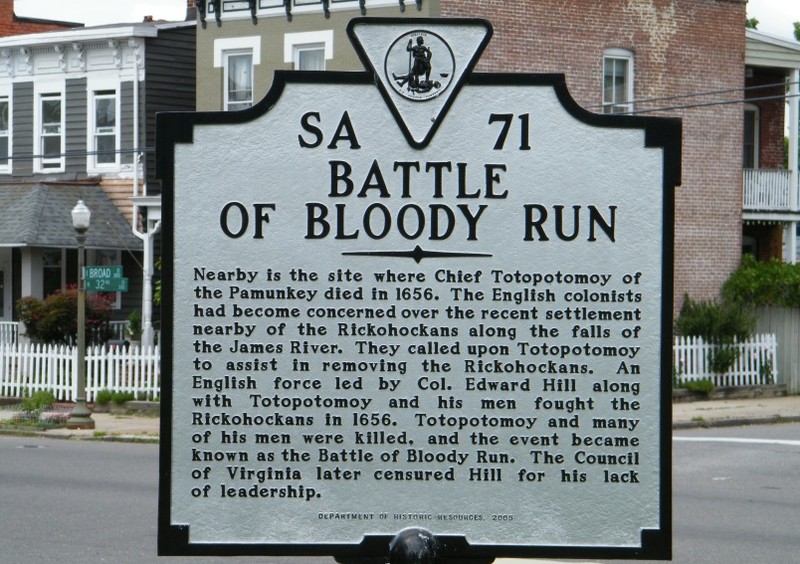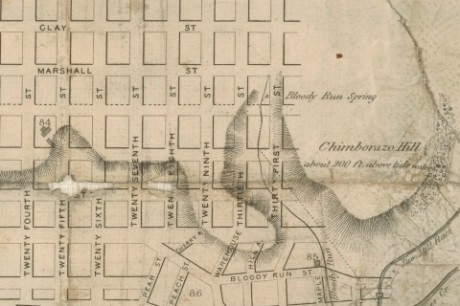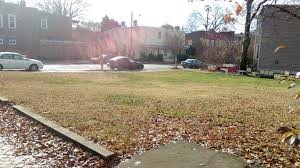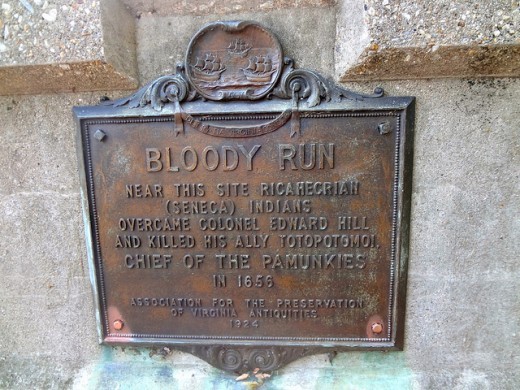Battle of Bloody Run-Richmond
Introduction
Text-to-speech Audio
Images
The Historical Marker

A map of Richmond showing Bloody Run Creek and Spring

What the area of the 1656 battle looks like today

A 1924 plaque commemorating the battle

Backstory and Context
Text-to-speech Audio
In the mid 1650s British Colonists in Virginia were facing a threat: the Rickohockan tribe of Native Americans. The Rickohockans were originally from Erie, now in Northwestern Pennsylvania. They had been steadily forced south by the Iroquois Nation and had now found a new area on the James River. This directly threatened British trade and interests in the region. In order to protect these assets the Virginia Council authorized Colonel Edward Hill to respond to this threat, with one hundred British troops as well as support from the local Native tribes, including the Pamunkey.
The Council’s orders to Hill were to remove the Rickohockans preferably using peaceful means, and military only as a last resort. Hill clearly ignored these instructions, and promptly attacked the Rickohockans. The coming battle was said to have been so intense that a natural spring in the area was colored red with the blood of the dead and wounded.
Seeing the intensity of the battle Hill ordered his men to retreat, which left Totopotomy and his Pamunkey troops alone and outnumbered against a powerful Rickohockan force. Most of the Pamunkey warriors were killed, along with their chief. Totopotomy’s wife Cockacoeske took over his position as Chief, and twenty years later was asked to send troops to put down Bacon’s Rebellion. She only sent twelve troops, despite having closer to one hundred twenty at her disposal. Clearly, the Pamunkey were not willing to forgive the Colonists for the death of their Chief.
However, Hill did not receive a warm reception from the Virginia Council either, and was officially reprimanded upon his return. For his lack of leadership, diplomacy and skill the Council decreed that: “his present suspension from all offices military and civil that he hath had or may have continue”.Noel
Bloody Run Creek, which was fed by the spring near the battle, became an important landmark and boundary for the quickly developing city of Richmond. Later in the 19th century it was used as a source of drinking water, and bathing water for the nearby Chimborazo Hospital. However, in 1884 the city purposefully buried the creek, which is no longer visible.Noel
While the Battle of Bloody Run may not have changed the balance of power in the New World it certainly offers a glimpse into the dangerous life which both colonists and native peoples had to endure in the 17th century Americas.Noel
Nearby is the site where Chief Totopotomoy of the Pamunkey died in 1656. The English colonists had become concerned over the recent settlement nearby of the Rickohockans along the falls of the James River. They called upon Totopotomoy to assist in removing the Rickohockans. An English force led by Col. Edward Hill along with Totopotomoy and his men fought the Rickohockans in 1656. Totopotomoy and many of his men were killed, and the event became known as the Battle of Bloody Run. The Council of Virginia later censured Hill for his lack of leadership.Battle of Bloody Run SA-71
